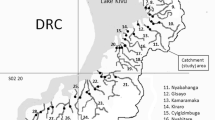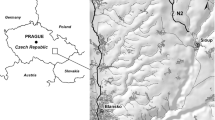Abstract
Compared with the aquatic ecosystem destruction caused by rapid urban development, substantial ecological restoration usually requires long periods and is a challenging process. Although river ecological restoration has been successful in different regions, the relationship between biodiversity, water quality, and effective measures applicable to developing countries remains poorly understood. This study was conducted in the Dasha River in Shenzhen city, one of the fastest-growing cities in China. The rehabilitation measures were sorted out in four phases to study the impact on water quality and biodiversity. In response, three campaigns were carried out to take phytoplankton, zooplankton, and benthos samples within the last three engineering stages, in 2007, 2012, and 2021. Synchronized investigations of water quality were conducted monthly from 2006 to 2021. Our analysis showed that the biodiversity of benthos has improved in recent years, which marks a turnaround for the aquatic ecological environment. According to the Hilsenhoff family biotic index (FBI), the water quality level in the 2021 campaign was promoted to “Good” in the downstream and “Fair” in the upper and middle streams. By analyzing Pearson’s correlations between response ratios of water quality parameters and the Shannon–Wiener index of phytoplankton, zooplankton, and benthos, we concluded that biodiversity is significantly related to water quality. Specifically, the biodiversity of zooplankton is associated with ammonia nitrogen (NH3-N) (R2 = − 0.77, P < 0.05), and benthos diversity is strongly negatively correlated with NH3-N, total nitrogen, chemical oxygen demand, and biochemical oxygen demand (R2 ≥ -0.82, P < 0.01). Despite the temporary negative impact of along-river interception on aquatic organisms in the campaign of 2012, the measures quickly and effectively improved water quality, which is the foundation for biodiversity improvement in 2021. This study provides insights into relationships among biodiversity, water quality, and regulation projects and can offer a reference for selecting aquatic ecosystem restoration measures in developing areas.






Similar content being viewed by others
Data availability
Not applicable.
References
Ambade B, Sethi SS (2021) Health risk assessment and characterization of polycyclic aromatic hydrocarbon from the hydrosphere. J Hazard Toxic Radioact Waste 25:1–11. https://doi.org/10.1061/(asce)hz.2153-5515.0000586
Ambade B, Sethi SS, Kurwadkar S, Mishra P, Tripathee L (2022) Accumulation of polycyclic aromatic hydrocarbons (PAHs) in surface sediment residues of Mahanadi River Estuary: abundance, source, and risk assessment. Mar Pollut Bull 183:114073. https://doi.org/10.1016/j.marpolbul.2022.114073
Arauzo M (2003) Harmful effects of un-ionised ammonia on the zooplankton community in a deep waste treatment pond. Water Res 37:1048–1054. https://doi.org/10.1016/S0043-1354(02)00454-2
Banks KE, Wood SH, Matthews C, Thuesen KA (2003) Joint acute toxicity of diazinon and copper to Ceriodaphnia dubia. Environ Toxicol Chem 22:1562–1567. https://doi.org/10.1897/1551-5028(2003)22%3c1562:JATODA%3e2.0.CO;2
Bozorg-Haddad O (2021) Economical, political, and social issues in water resources. Elsevier, Amsterdam. https://doi.org/10.1016/C2020-0-03830-2
Fu G, Zhao L, Wu J, Hu Z, Hu K, Dong Y (2020) Ecological function evaluation and restoration strategy of rivers in urban built-up areas: a case study of the Dasha River in Shenzhen. J Shenzhen Univ Sci Eng 37:372–380
Fu H, Gaüzère P, García Molinos J, Zhang P, Zhang H, Zhang M, Niu Y, Yu H, Brown LE, Xu J (2021) Mitigation of urbanization effects on aquatic ecosystems by synchronous ecological restoration. Water Res 204:117587. https://doi.org/10.1016/j.watres.2021.117587
Grandgirard J, Poinsot D, Krespi L, Nénon JP, Cortesero AM (2002) Costs of secondary parasitism in the facultative hyperparasitoid Pachycrepoideus dubius: does host size matter? Entomol Exp Appl 103:239–248. https://doi.org/10.1046/j.1570-7458.2002.00982.x
Hasan MF, Nur-E-alam M, Salam MA, Rahman H, Paul SC, Rak AE, Ambade B, Towfiqul Islam ARM (2021) Health risk and water quality assessment of surface water in an urban river of Bangladesh. Sustain 13:1–22. https://doi.org/10.3390/su13126832
Hilsenhoff WL (1988) Rapid field assessment of organic pollution with a family-level biotic index. J North Am Benthol Soc 7:65–68. https://doi.org/10.2307/1467832
Huang Y, Wang Y, Liu Z, Zeng X, Chen L (2008) Stream construction characteristics in rapid urbanization area: Shenzhen city as a case (in chinese). J Geogr Res 27:1212–1220
Jepsen PM, Andersen CVB, Schjelde J, Hansen BW (2015) Tolerance of un-ionized ammonia in live feed cultures of the calanoid copepod Acartia tonsa Dana. Aquac Res 46:420–431. https://doi.org/10.1111/are.12190
Ji Z (2017) Hydrodynamics and water quality: Modeling rivers, lakes, and estuaries. John Wiley & Sons, Hoboken. https://doi.org/10.1002/9781119371946
Kurwadkar S, Sethi SS, Mishra P, Ambade B (2022) Unregulated discharge of wastewater in the Mahanadi River Basin: risk evaluation due to occurrence of polycyclic aromatic hydrocarbon in surface water and sediments. Mar Pollut Bull 179:113686. https://doi.org/10.1016/j.marpolbul.2022.113686
Liu J, Chen F, Cui Q, Jiang Y (2011) Ecological effect caused by hydraulic engineering construction. Front Earth Sci 5:170–177. https://doi.org/10.1007/s11707-011-0155-4
Liu G, Yang Z, Chen B, Ulgiati S (2014) Emergy-based dynamic mechanisms of urban development, resource consumption and environmental impacts. Ecol Modell 271:90–102. https://doi.org/10.1016/j.ecolmodel.2013.08.014
Liu C, Cai W, Zhai M, Zhu G, Zhang C, Jiang Z (2021) Decoupling of wastewater eco-environmental damage and China’s economic development. Sci Total Environ 789:147980. https://doi.org/10.1016/j.scitotenv.2021.147980
Lu ZN, Chen H, Hao Y, Wang J, Song X, Mok TM (2017) The dynamic relationship between environmental pollution, economic development and public health: evidence from China. J Clean Prod 166:134–147. https://doi.org/10.1016/j.jclepro.2017.08.010
Lu Y, Zhang Y, Cao X, Wang C, Wang Y, Zhang M, Ferrier RC, Jenkins A, Yuan J, Bailey MJ, Chen D, Tian H, Li H, von Weizsäcker EU, Zhang Z (2019) Forty years of reform and opening up: China’s progress toward a sustainable path. Sci Adv 5:1–11. https://doi.org/10.1126/sciadv.aau9413
Made Atmaja D, Budiastuti MS, Setyono P, Sunarto S (2017) Sediment characteristics and benthos community spread in Lake Beratan in Bali. In 1st International Conference on Geography and Education (ICGE 2016), pp 76–80. https://doi.org/10.2991/icge-16.2017.15
Mandaville SM (2002) Benthic macroinvertebrates in freshwaters - Taxa tolerance values, metrics, and protocols, project H-1. Soil & Water Conservation Society of Metro Halifax, Nova Scotia, pp 85–98
Martins RT, Stephan N, Alves RG (2008) Tubificidae (Annelida: Oligochaeta) as an indicator of water quality in an urban stream in southeast Brazil Tubificidae (Annelida: Oligochaeta) como indicador da qualidade da água de um córrego urbano do sudeste Brasileiro. Acta Limnol Bras 20:221–226
Meshram SG, Singh SK, Meshram C, Deo RC, Ambade B (2018) Statistical evaluation of rainfall time series in concurrence with agriculture and water resources of Ken River basin, Central India (1901–2010). Theor Appl Climatol 134:1231–1243. https://doi.org/10.1007/s00704-017-2335-y
Miltner RJ, White D, Yoder C (2004) The biotic integrity of streams in urban and suburbanizing landscapes. Landsc Urban Plan 69:87–100. https://doi.org/10.1016/j.landurbplan.2003.10.032
MoHURD, 2020( 2019) Urban Construction Statistical Yearbook (in chinese)
NBSPRC (2021) China Statistical Yearbook 2020. China Statistics Press, Peking
Qin CY, Zhou J, Cao Y, Zhang Y, Hughes RM, Wang BX (2014) Quantitative tolerance values for common stream benthic macroinvertebrates in the Yangtze River Delta, Eastern China. Environ Monit Assess 186:5883–5895. https://doi.org/10.1007/s10661-014-3826-2
Rashid Gill A, Viswanathan KK, Hassan S (2018) The environmental Kuznets curve (EKC) and the environmental problem of the day. Renew Sustain Energy Rev 81:1636–1642. https://doi.org/10.1016/j.rser.2017.05.247
Real M, Rieradevall M, Prat N (2000) Chironomus species (Diptera: Chironomidae) in the profundal benthos of Spanish reservoirs and lakes: factors affecting distribution patterns. Freshw Biol 43:1–18. https://doi.org/10.1046/j.1365-2427.2000.00508.x
Rey Benayas JM, Newton AC, Diaz A, Bullock JM (2009) Enhancement of biodiversity and ecosystem services by ecological restoration: a meta-analysis. Science (80-. ) 325:1121–1124. https://doi.org/10.1126/science.1172460
Rimet F, Cauchie HM, Hoffmann L, Ector L (2005) Response of diatom indices to simulated water quality improvements in a river. J Appl Phycol 17:119–128. https://doi.org/10.1007/s10811-005-4801-7
Rosa BJFV, Rodrigues LFT, de Oliveira GS, da Gama Alves R (2014) Chironomidae and Oligochaeta for water quality evaluation in an urban river in southeastern Brazil. Environ Monit Assess 186:7771–7779. https://doi.org/10.1007/s10661-014-3965-5
Ruoff G (2009) Grow rich and clean up later? Joint effects of IGO membership and democracy on environmental performance in developing countries. In annual meeting of the ISA’s 50th Annual Convention, “Exploring the Past, Anticipating the Future”, New York Marriott Marquis, New York City, NY
Shannon CE (1948) A mathematical theory of communication. Bell Syst Tech J 27:379–423
Talamini G, Shao D, Su X, Guo X, Ji X (2017) Combined sewer overflow in Shenzhen, China: the case study of Dasha River. WIT Trans Ecol Environ 210:785–796. https://doi.org/10.2495/sdp160661
Tan X, Sheldon F, Bunn SE, Zhang Q (2013) Using diatom indices for water quality assessment in a subtropical river. China Environ Sci Pollut Res 20:4164–4175. https://doi.org/10.1007/s11356-012-1343-9
Wang BX, Yang LF (2004) A study on tolerance values of benthic macroinvertebrate taxa in Eastern China. Acta Ecol Sin 24:2768–2775
Wang L, Lyons J, Kanehl P, Bannerman R (2001) Impacts of urbanization on stream habitat and fish across multiple spatial scales. Environ Manage 28:255–266. https://doi.org/10.1007/s0026702409
Wang L, Yu L, Xiong Y, Li Z, Geng J (2021) Study on the governance of black-odor water in Chinese cities. J Clean Prod 308:127290. https://doi.org/10.1016/j.jclepro.2021.127290
Wei FC, Qi WQ, Sun ZG (2002) Standard methods for examination of water and wastewater (Chinese). China Environmental Science Press, China
Yang J, Holbach A, Wilhelms A, Qin Y, Zheng B, Zou H, Qin B, Zhu G, Norra S (2019) Highly time-resolved analysis of seasonal water dynamics and algal kinetics based on in-situ multi-sensor-system monitoring data in Lake Taihu. China Sci Total Environ 660:329–339. https://doi.org/10.1016/j.scitotenv.2019.01.044
Young SS, Yang HN, Huang DJ, Liu SM, Huang YH, Chiang CT, Liu JW (2014) Using benthic macroinvertebrate and fish communities as bioindicators of the Tanshui river basin around the greater Taipei area - multivariate analysis of spatial variation related to levels of water pollution. Int J Environ Res Public Health 11:7116–7143. https://doi.org/10.3390/ijerph110707116
Zhao J, Yang Y, Zhao Q, Zhao Z (2017) Effects of ecological restoration projects on changes in land cover: a case study on the Loess Plateau in China. Sci Rep 7:1–12. https://doi.org/10.1038/srep44496
Zhu W, Wang J, Xue F, Chen S (2018) Integrated solutions for urban water issues (chinese). Phoenix Science Press Ltd, Nanjing
Funding
This work was supported by the Shenzhen Science and Technology Plan Project (grant.-no.: JSGG20210802153010033).
Author information
Authors and Affiliations
Contributions
Jingwei Yang: data analysis and writing and editing. Yilong Huang: supervision, fieldwork, reviewing, and editing. Xuepeng Liu: suggestion and data acquisition. Ruiying Jing: fieldwork arrangement and sample testing. Chang Liu: fieldwork.
Corresponding author
Ethics declarations
Ethics approval
The study does not need ethical approval.
Consent to participate
Not applicable.
Consent for publication
All authors read, approved, and provided their consent on the publication of the final version of this manuscript.
Competing interests
The authors declare no competing interests.
Additional information
Responsible Editor: Thomas Hein
Publisher's note
Springer Nature remains neutral with regard to jurisdictional claims in published maps and institutional affiliations.
Rights and permissions
Springer Nature or its licensor (e.g. a society or other partner) holds exclusive rights to this article under a publishing agreement with the author(s) or other rightsholder(s); author self-archiving of the accepted manuscript version of this article is solely governed by the terms of such publishing agreement and applicable law.
About this article
Cite this article
Yang, J., Huang, Y., Liu, X. et al. From collapse to the health of the aquatic ecosystem in Dasha River (2006–2021): a case study of Shenzhen city in the Guangdong-Hong Kong-Macao Greater Bay Area, China. Environ Sci Pollut Res 30, 49097–49107 (2023). https://doi.org/10.1007/s11356-023-25773-4
Received:
Accepted:
Published:
Issue Date:
DOI: https://doi.org/10.1007/s11356-023-25773-4




